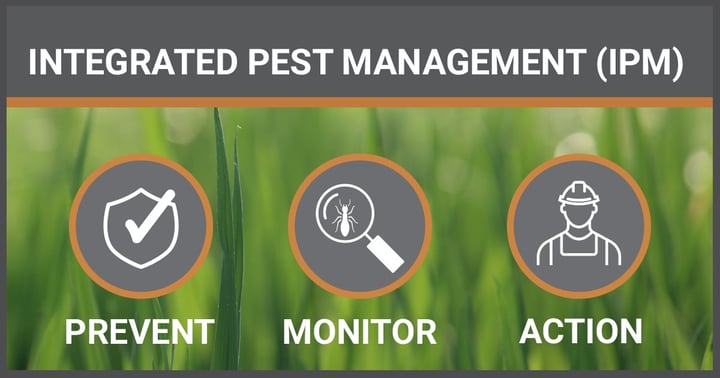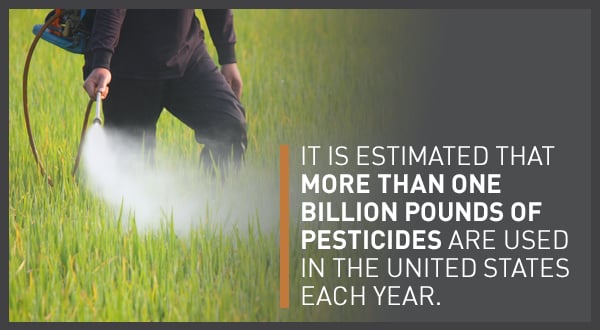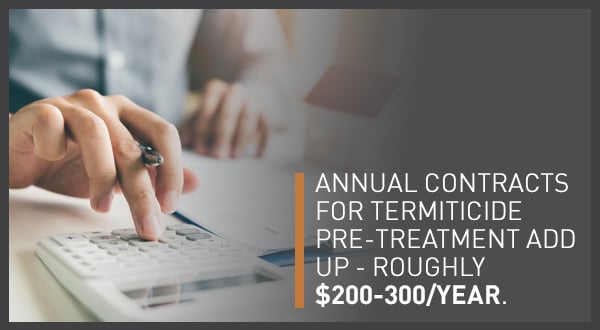Why Integrated Pest Management (IPM) is Critical in Construction
Discover the Environmental and Long-Term Cost Benefits Associated with an Effective Protection Strategy Against Subterranean Termites
Think about how differently we construct buildings today: building envelopes are dramatically tighter; individual building materials are more sustainable, and the entire system of a building’s construction is vastly more energy-efficient.
Then consider the practices and components the building industry has left behind with the times. For example, we have not only outlawed the use of asbestos for insulation and lead paint on our walls, we actively regulate their presence in our built environment and mitigate the potential harm they can still cause in older buildings.
So why is it that we continue to use harmful chemical termiticide as the sole means to prevent termite infestation?
The chemical industry might have you believe that termiticide is the only effective means to prevent termite infestation. Not only is this not true, but the alternatives are also not new.
Integrated pest management (IPM) offers an effective pest control strategy – aligned with green building practices – that can eliminate or minimize the use of pesticides in our living and working environments.
While IPM is not a new concept, it is less understood than long-held beliefs about pesticides. It can solve pest problems and, more importantly, prevent pests from becoming a problem in the first place.
A sound IPM plan can accomplish these goals while minimizing the risks to people, pets, non-target species, and the environment in general; all risks inherent with traditional, pesticide-based, pest management. IPM strategies can be applied to new construction, existing structures, agricultural settings and can be effective against a wide range of pest species.
This article will explain key aspects of IPM in the areas of new construction and subterranean termite protection, and why it could be a great solution for you.
By incorporating a physical termite barrier under-slab or within your crawl space, you help ensure the structural integrity of your home will not be compromised by termite attack and eliminate or reduce the amount of chemical pesticide exposure to your family, pets, and the environment.
What is IPM?
Definitions of IPM vary depending on the source, but the principles and strategies are universal. One definition that gets to the heart of IPM comes from the University of California Agriculture and Natural Resources:
“IPM is an ecosystem-based strategy that focuses on long-term prevention of pests or their damage through a combination of techniques such as biological control, habitat manipulation, modification of cultural practices, and use of resistant varieties. Pesticides are used only after monitoring indicates they are needed according to established guidelines, and treatments are made with the goal of removing only the target organism. Pest control materials are selected and applied in a manner that minimizes risks to human health, beneficial and nontarget organisms, and the environment.”
Let’s break out the four key principles of IPM outlined within this definition.
- IPM is an “ecosystem-based” strategy, meaning that an IPM approach doesn’t rely on a single pest control method. Rather, IPM involves multiple prevention methods and strategies. For termites, the strategy relies heavily on physical barriers, smart landscaping choices, and generally making a structure less inviting. This means attempting to eliminate food, shelter, sources of moisture, and to block access to the structure.
- IPM focuses on “…long-term prevention of pests…” The pre-treatment option of termite control (saturating the soil with pesticide) can provide protection temporarily but will need regular reapplication of termiticides throughout the life of the building. When opting for termiticide treatments as a sole means of defense, you are signing up to create a toxic moat around your home for the life of the structure. IPM instead seeks to make the use of pesticides unnecessary through prevention strategies.
- Pesticides are not off the table as an option with IPM, but rather intended to be the tool of last resort should an infestation be detected. With an active termite infestation, pesticides may be the best solution. What IPM principals advocate for is the targeted and judicious use of these harmful chemicals only when necessary. After all, these structures are our homes, schools, hospitals, etc. where people, pets, and other wildlife reside. Shouldn’t the healthier/safest option be to use pesticides as a last resort?
- Physical barriers to termites (and other pests) are the backbone of any IPM strategy. Habitat manipulation is a good step towards pest prevention but using a physical barrier to block access gives the assurance that an effective level of protection is in place for a determined foraging subterranean termite. Barrier products, by definition, do not contain pesticides and can provide long-lasting protection that is not harmful to people, pets, other critters, water sources, and the environment in general.
Now that you have a basic understanding of what IPM is and the principles behind it, the big questions to ask yourself are:
- Why should you consider this approach to pest management, and
- Is IPM the right strategy for you?
Environmental & Cost Benefits of Using an IPM Strategy
The reasons why IPM should be considered are many and we’ve touched on a few of them in the paragraphs above. Let’s start with the elimination/reduction of the use of chemical termiticides.
 The National Center for Biotechnology Information (NCBI) estimates that more than one billion pounds of pesticides are used in the United States each year. Not all of this total is termiticides but given the widespread practice of pre-treating the soil before construction and the massive industry based on regular reapplication of these chemicals, termiticides certainly are a significant contributor.
The National Center for Biotechnology Information (NCBI) estimates that more than one billion pounds of pesticides are used in the United States each year. Not all of this total is termiticides but given the widespread practice of pre-treating the soil before construction and the massive industry based on regular reapplication of these chemicals, termiticides certainly are a significant contributor.
This article is not intended to bash the use of pesticides or create any unnecessary fear of pesticides, but everyone can agree that the less poison we put into the soil and waterways the better for the environment.
Common sense also dictates that reducing human exposure to these types of chemicals is a good thing. The National Green Building Standard (NGBS) and the U.S. Green Building Council (USGBC) certainly think so. For structures seeking USGBC LEED certification or NGBS Green certification, installing a physical termite barrier as part of an IPM strategy will contribute towards earning your certification. Regardless of whether you intend to seek an NGBS or LEED certification, the knowledge that your family, pets and the environment in which you live and/or work is pesticide-free is valuable peace of mind.
Reducing the amount of pesticide load in our environment is not a difficult concept to get behind and support. So why do people continue the practice of pre-treating the soil with termiticides?
-
Awareness: IPM and green building practices are still relatively new when compared to pesticide treatments.
-
Cost: Without question, a termiticide pre-treatment is cheap, at least in terms of up-front cost when compared to an IPM/physical barrier approach.
Compare costs associated with IPM/physical barrier and termiticide treatments. For the sake of this example, let’s use a 1,000 sq.ft. footprint. Keep in mind that costs can vary greatly by region and by product selection.
- Termiticide pre-treatment cost - $150 - $400
- IPM - Physical barrier cost - $1,000 - $2,500
It’s understandable why many people would abandon the idea of using a physical barrier at this point. The problem with evaluating these options based on the up-front cost is that in no way is it representative of what you should expect to pay for the life of the building.
 A more in-depth look at the long-term costs of relying on termiticide treatments can show that employing a physical barrier as part of an IPM strategy is more attractive. Pre-treatments will require an annual contract in order to maintain your warranty. Again, costs vary by region and the size of the structure, but a good estimate for the yearly cost is going to be $200-300. It doesn’t take many years before the annual cost of your contract catches up to the up-front cost of a physical termite barrier.
A more in-depth look at the long-term costs of relying on termiticide treatments can show that employing a physical barrier as part of an IPM strategy is more attractive. Pre-treatments will require an annual contract in order to maintain your warranty. Again, costs vary by region and the size of the structure, but a good estimate for the yearly cost is going to be $200-300. It doesn’t take many years before the annual cost of your contract catches up to the up-front cost of a physical termite barrier.
Additionally, termiticides degrade in the environment over time, requiring periodic reapplication to maintain a chemical barrier. There are many variables that can affect the length of time a termiticide will remain effective in the soil, but five years is generally the most you can expect. Certain soil conditions and contact with concrete (high pH levels) will degrade these termiticides to the point of ineffectiveness much sooner than that. Considering that reapplying termiticides underneath your structure often means drilling holes through your slab, it is not commonly done. Unless (until) that is, termites are discovered entering your structure from below. Your “cost-effective” pre-treatment just got a heck of a lot more expensive in this common scenario.
Whether you choose to pre-treat or go with a non-toxic termite treatment such as a physical barrier, the perimeter of your structure is still vulnerable to termite attack. Trenching around the foundation and saturating the soil with termiticide to create a chemical barrier is a common practice, as are placing bait stations around the perimeter. Bait stations, naturally, are much more environmentally friendly and more closely aligned with the principles of IPM.
We’ve covered the environmental benefits of using an IPM strategy for subterranean termite management, and we’ve discussed the cost structure of pre-treatment vs. physical barriers. This all points toward IPM as a viable strategy. However, environmental and cost benefits don’t mean much unless IPM is effective at actually preventing termite attack. Using bait stations as a monitoring device, while maintaining a buffer between your foundation and any mulch, shrubs, or other foliage as part of the overall IPM strategy, is a proven and effective method of termite prevention. Particle barriers are another great option for perimeter protection.
.png?width=600&name=Pango-Wrap-Job-Site-600x442%20(2).png) These steps, combined with an under slab physical termite barrier, create a formidable defense against termite attack. There are several reputable manufacturers of physical termite barrier products that provide protection every bit as good as a pre-treatment and, depending on the product, will provide protection well beyond the lifespan of soil-applied termiticide. Some barriers provide additional protection against moisture vapor and soil gases, which can add to the overall value of your investment.
These steps, combined with an under slab physical termite barrier, create a formidable defense against termite attack. There are several reputable manufacturers of physical termite barrier products that provide protection every bit as good as a pre-treatment and, depending on the product, will provide protection well beyond the lifespan of soil-applied termiticide. Some barriers provide additional protection against moisture vapor and soil gases, which can add to the overall value of your investment.
In short, IPM as a concept, wouldn’t be a thing if it wasn’t effective.
So, what can IPM do for you?
IPM can provide a strategy for protection against subterranean termites that is effective, in line with modern green building practices, and comparable with termiticides in cost when factoring in annual application/contract costs, all while preventing accidental exposure to your family, pets, and non-target species.
Before selecting your pest control professional, ask them about their IPM strategies for subterranean termite protection. A great shortcut when evaluating pest management companies is finding those that are GreenPro Certified by the NPMA (National Pest Management Association). GreenPro certification ensures that the company is well versed in IPM and will be able to help develop an IPM strategy specifically for you.
IPM can send chemical termiticides into the realm of the obsolete, just like we’ve done with asbestos and lead paint. The alternative is viable, sustainable, and cost-effective in the long run.

Written by Ryan Goodwin
Ryan Goodwin is the Pango® Product Manager at Stego Industries, LLC. He has been a part of the Stego team for over fifteen years with previous roles as the Regional Manager and Regional Director for Texas, Oklahoma, and Louisiana. As the Pango Product Manager, Ryan was a part of the team that developed Pango Wrap. Ryan appreciates working with design professionals, pest management professionals, and contractors to promote Integrated Pest Management practices and sustainable solutions for pest control.
- Stego (26)
- StegoCrawl (24)
- Stego-Awareness (17)
- StegoHome (15)
- Case Studies (14)
- StegoCrawl-Consideration (12)
- StegoCrawl-Awareness (11)
- Customer Stories (9)
- Stego-Consideration (9)
- Pango (8)
- StegoHome-Consideration (8)
- Beast (7)
- How to Install (7)
- StegoHome-Awareness (7)
- Drago (5)
- Pango-Awareness (5)
- Beast-Awareness (4)
- Beast-Consideration (3)
- Drago-Awareness (3)
- Pango-Consideration (3)
- Stego IQ (3)
- Drago-Consideration (2)
- StegoCrawl-Decision (2)
Popular Posts
Stay Connected.
Enter your email below.








Post Comments